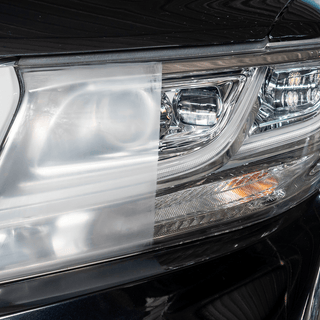
Restore Your Headlights: Effective Methods for Cleaning Foggy Lenses
Headlights are exposed to moisture, especially during rain or car washes. When water seeps into the microscopic cracks and scratches on the lenses, it can react with the plastic, causing hazy formations. This moisture-induced haziness, coupled with UV exposure, accelerates the yellowing process, making your headlights look like they’ve aged before their time. Years ago, I did a video on How to Fix Yellow Headlights, where I restored the headlight lenses on my 2007 Lexus ES350 - they were pretty bad. After some much-needed TLC, I was able to get them back to like-new condition.
Clear headlights are not just about aesthetics, although I must admit, they sure do make your car look a thousand times better. On the flip side of that, it’s also important to keep safety in mind. You need to have clear visibility not only for yourself but for others on the road to see you.
I’m going to talk to you about how to restore the headlights on your vehicle and also the preventative measures you can take to keep them looking pristine.
But, Why Do Headlights Yellow?
The Sun, Our Not-So-Friendly Neighbor
Imagine your headlights as your car’s sunglasses – they shield your car’s sensitive eyes (or rather, bulbs) from the harsh sunlight. However, just like your favorite shades can fade over time, headlights are vulnerable, too. The relentless UV rays from the sun oxidize the plastic lenses, causing them to lose their clarity and adopt that yellowish tint. Think of it as a sunburn for your headlights – but instead of red, they turn yellow.
Road Grime and Pollution
Our cars brave the wild outdoors, facing a barrage of road debris, dirt, and pollution daily. Tiny particles in the air settle on the headlights, slowly but surely dimming their brightness. Chemical reactions occur, further intensifying the yellowing effect. It’s like a smoggy veil descending upon your once-clear headlights.
Bug Splatter Drama
Ah, the classic road trip scenario – bugs meeting their fate on your windshield and, unfortunately, your headlights too. When these little critters meet your headlights at high speeds, their guts can leave behind residues that stick to the lenses. Over time, these residues break down and contribute to the yellowing process, making your headlights lose their true (clear) identity.
Moisture and Humidity
Now, I mentioned this before, but it’s something I want to touch on again - the sneaky moisture and humidity duo plays a major role in foggy and yellowing headlights. When water buddies up with microscopic scratches on your headlight lenses, a foggy partnership is born. This moisture mischief, coupled with the ever-present humidity, creates a perfect storm for those lenses to haze up. It's like your headlights decided to embrace the misty look, but unfortunately, it's not the fashion statement you're going for. So, when you notice your headlights going all foggy on you, blame it on Mother Nature’s tag team – moisture and humidity.
Steps On How to Clear Up Those Foggy Headlights
With a little elbow grease and patience, you can clear up those foggy, yellowing headlight lenses in just a few hours. Even if you’re not a professional detailer, watching a headlight restoration video online that will walk you through the process step by step can be a great help.
- Assessment: The first step is a thorough assessment of the headlights. Examine the level of damage, noting any deep scratches, oxidation, or other issues that may impact the restoration process.
- Cleaning and Prepping: Before diving into the restoration, the headlights are cleaned to remove any surface dirt, grime, or bugs. Cleaning ensures a clear surface for the restoration process.
- Sanding: You’ll want to use wet sanding techniques to remove stubborn oxidation and deeper scratches. This step requires precision to avoid over-sanding, which can damage the lenses further.
- Compounding: After sanding, a compound is applied. This compound helps to remove finer scratches and smooth out the surface of the headlights. It's a crucial step in achieving that crystal-clear finish.
- Polishing: Polishing is the next dance move in the restoration routine. A high-quality polishing compound is applied to bring out the shine and restore the clarity of the headlights.
- Protective Coating: To seal the deal (literally), a protective coating is applied. This coating acts as a shield, protecting the headlights from UV rays and environmental factors that could lead to future yellowing or damage. You have a few options here. You could use a wax, spray sealant, ceramic coating, or even PPF (paint protection film) if you want it to last a very long time.
- Quality Check: Us pros don't call it a day until we’ve done a thorough quality check - I suggest you do the same. We’re ensuring that the headlights are not only restored to their former glory but also meet the high standards of high level detailing. I’m not telling you to be a perfectionist, but if you made it this far, why not be sure you did a solid job?
You’ve done all of this hard work, but going forward, you also want to maintain the cleanliness of your car. Having a new set of lenses is half the battle; the other half is keeping those headlights clean and crystal clear. I know you can do it!
Tools to Use for Headlight Restoration
- Wet Sandpaper: Various grits of wet sandpaper (ranging from coarse to fine) for the sanding process.
- Sanding Block: A sanding block to ensure even and controlled sanding on the headlight surface.
- Water Source: A water source, often in the form of a spray bottle, to keep the sandpaper wet during the wet sanding process.
- Electric Polisher: An electric polisher, also known as a rotary or orbital buffer, for the compounding and polishing stages. This tool helps achieve a smooth and glossy finish.
- Compounding Pads: Pads specifically designed for applying the compounding solution during the compounding stage.
- Polishing Pads: Different polishing pads for the polishing stage, ensuring a high-gloss finish.
- Masking Tape: High-quality masking tape to protect the surrounding areas of the headlight during the restoration process.
- Polishing Compound: Professional-grade polishing compounds to remove fine scratches and restore clarity.
- Protective Coating: UV-resistant protective coatings to apply after restoration, providing long-term protection against yellowing and environmental damage. This can be a wax, spray sealant, ceramic coating, or PPF (paint protection film).
- Microfiber Towels: Soft and lint-free microfiber towels for wiping and buffing the surfaces during various stages of the restoration.
- Safety Equipment: Safety glasses to protect the eyes during sanding and polishing processes.
- Dust Mask: A dust mask to protect against inhalation of particles generated during sanding and polishing.
- Cleaning Solutions: Cleaning solutions or degreasers to clean the headlights before the restoration process.
So, there you have it. Headlight restoration might sound like a bit of work, but trust me, it's the kind of effort that pays off in the long run. Yeah, your headlights might be doing the yellowing tango now, but with a bit of elbow grease, proper techniques, and tools, you can bring back that showroom shine. Clear headlights aren't just for looks; they're your ride's eyes on the road. Better visibility, safer driving, and a ride that turns heads – that's the sweet reward for giving your headlights a little love.
So, roll up those sleeves, grab your tools, and let's bid farewell to the yellow haze. Your car will thank you, and you'll be cruising down the road with a clear view and a clear style.
